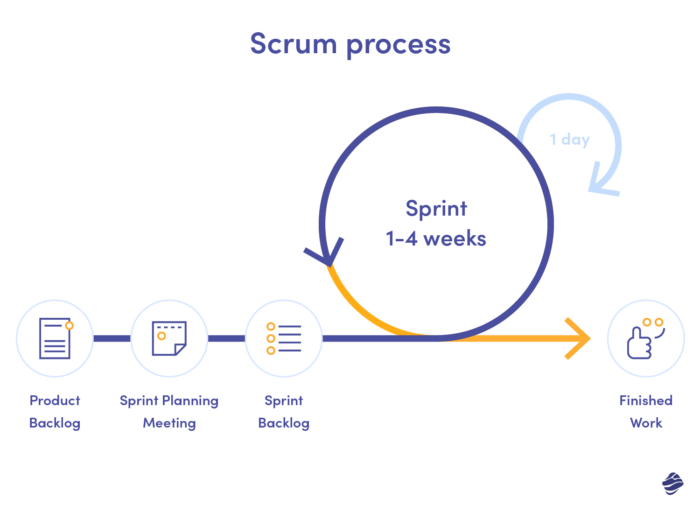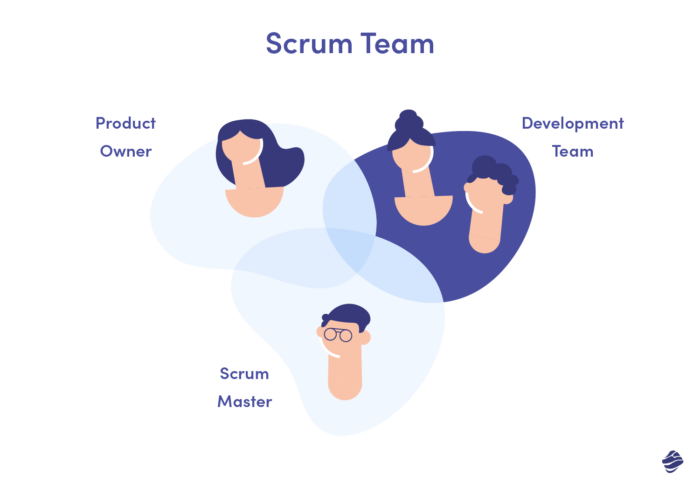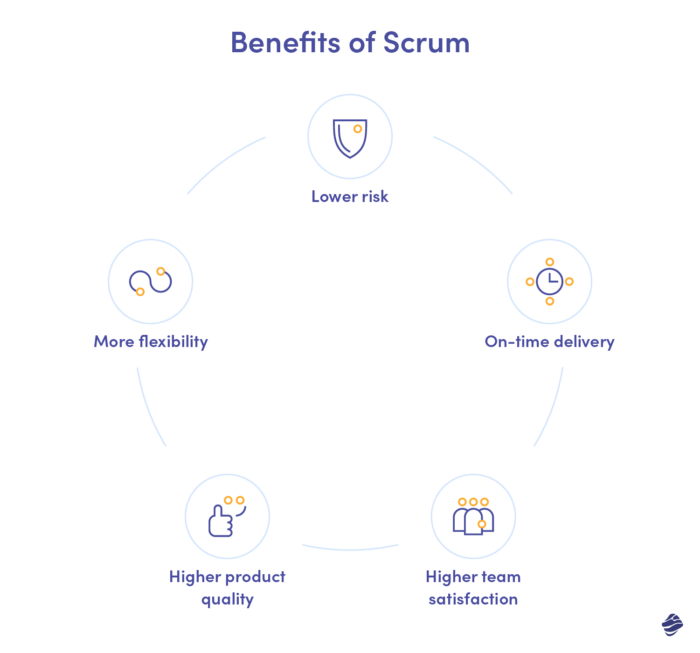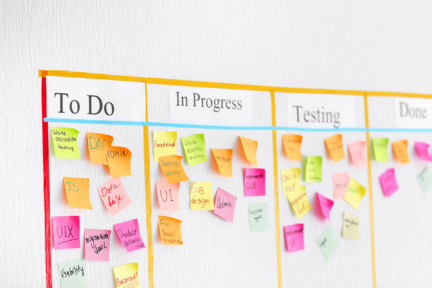One of the Scrum gurus – Jeff Sutherland – once said: “Greatness can’t be imposed; it has to come from within. But it does live within all of us.”
Let’s absorb the wisdom coming out of this quote. It acknowledges the fact that we all possess a capacity for doing extraordinary things. Most of us just need some help, guidance, a framework to operate within and define the stepping stones we can use to fly. Easy to say, harder to do, but worth searching for, right? Undoubtedly, one such stepping stone in your professional development might be the Scrum methodology, a part of a bigger concept of Agile.
In this article, we’ll look closely at the Scrum framework. You’ll find out what this widespread Agile methodology is for, how your software project can benefit from it, and how to manage it. Let’s cut to the chase!
What exactly is Scrum?
Scrum is one of the most widely applied Agile methodologies for managing complex projects with strict deadlines and well-defined requirements. Even though this framework works very well in various project types, it is most often employed in software product engineering services.
The primary assumption of Scrum is that in this Agile project management framework, a complex project gets divided into smaller parts called iterations (sprints) that usually last from one to four weeks. Scrum can be easily adaptable to a project’s needs, and what’s more, its process and all the actions taken are entirely transparent and constantly include the customer’s perspective in development.
What are Scrum Artifacts?
Scrum artefacts are tangible elements within the framework that can help manage projects. They include the Product Backlog, Sprint Backlog, and Increment.
Product Backlog
The Product Backlog is like the heartbeat of a Scrum project. It’s a dynamic, prioritised list of all the work needed on a product. However, it’s more than just a list; it reflects the product’s vision.
The Product Backlog is a living document, and it’s continuously updated based on feedback, changes in the market, or even the team’s evolving understanding of the product’s requirements. This ensures that the product remains adaptable and up-to-date.
Sprint Backlog
The Sprint Backlog, to put it simply, is a plan for a specific sprint, which is a time-boxed period (usually 2-4 weeks).
During the sprint, the team holds regular standup meetings to discuss progress and adapt to challenges as necessary. This dynamic planning is a crucial factor in the adaptability of Scrum.
Increment
The Increment is the tangible outcome of a sprint. It’s the sum of all the work completed within that sprint. This means that at the end of every sprint, a piece of the product could be released to customers if the Product Owner decides to do so.
The Increment allows stakeholders to see real, measurable progress after each sprint. This contrasts starkly with traditional project management, where progress is often hidden until the end of a project.
In summary, these artefacts serve as essential tools in the Scrum framework, promoting transparency, inspection, and adaptation, ultimately driving a successful product development process.
Scrum are Scrum Events?
The Scrum process flow is quite simple to understand as it consists of a few mostly repetitive steps. The diagram below summarises it:

To get a better understanding of the whole Scrum software development process, let’s go through it point by point:
- Product Backlog: At this stage, the Product Owner together with Scrum Master (and in some cases, collectively with the whole Scrum team) define the Product Backlog, i.e. all the tasks that should be completed to release the software product.
- Sprint Planning Meeting: All tasks set for the following sprint are identified during this meeting. Basically, it means that during SPM each team member finds out what they will do during the next few weeks. SPM should be held prior to the sprint so that everyone has a chance to determine if they can complete all assigned tasks on time.
- Sprint: Now, it is time for the intensive development work. During the current sprint, all the tasks assigned during SPM move to Sprint Backlog. The Scrum sprint takes mainly from 1 to 4 weeks, however, the spring duration depends entirely on the Scrum team.
- Daily Scrum: To ensure that the whole Scrum team is on the right track to achieve the defined sprint goal and that the work progresses as intended, the team gathers every day for daily Scrum meetings to update each other and briefly report on the status of the tasks.
- Sprint review: During the sprint review meeting, the Scrum team presents what they have managed to complete and what still needs to be done.
- Once the sprint is finished, the team gathers for the Sprint Retrospective meeting, where they have a chance to make some suggestions or share some ideas. Based on the conclusions from this meeting, they can introduce improvements to the next sprint planning.
Keep in mind that the Scrum process flow can be customised and adjusted to your software project. Whatever suits your and the Scrum team’s needs!
Scrum team members: Who is who?
Scrum methodology has three prominent roles: Scrum Master, Product Owner (PO) and Development team. They all combine to form a Scrum team that joins forces to reach the common goal, which is to provide a solution to a complex problem. But who is responsible for what in particular? Let’s find out!
Scrum Master serves primarily as a guide, as someone who is an expert in Scrum and knows it far enough to ensure that everything in the project is done perfectly. What’s more, a Scrum Master, as the methodology’s advocate, helps the rest of the Scrum team to understand it better. In simple terms, this is a strictly leadership role that keeps everything in check and assures that the entire Scrum team works towards the same goal.
These are the primary responsibilities of Scrum Masters:
- planning of subsequent sprints and their scope
- coordinating the work of the team to ensure that the top-quality project is delivered on time
- maintaining the product backlog
- promoting Scrum and its philosophy among the team members
- collaborating closely with the Product Owner on setting the project’s direction
- managing risks and removing any obstacles that may arise throughout the entire project.
The Product Owner represents the business perspective of the software development project. It is this person that identifies features that have the greatest business value and then prioritises them. The Product Owner needs to maximise ROI (return on investment), ensuring that the final product will fully respond to market demands and satisfy user expectations.
In Scrum, the Product Owner takes on the following day-to-day responsibilities:
- keeping in touch with stakeholders and updating them on the project’s progress
- prioritising actions in subsequent sprints
- determining which features must be implemented to achieve the overall product scope
- assessing the development team’s work
- holding responsibility for the product’s ROI.
Importantly, Product Owners are often mistaken for Project Managers. However, these are entirely different roles. Check the Product Owner vs Project Manager comparison to learn about their main differences.
A development team is the heart and the soul of the Scrum project. It is thanks to them that the subsequent features can be delivered within the specified timeline.
Importantly, such a team can (and should) be formed by experts in various fields, not solely by software engineers. Depending on the project’s needs, the development team should also include designers, testers, writers, data scientists, etc. After all, development team members should have different responsibilities depending on their expertise. However, they all should bring tremendous value to the project.
The development team’s job includes:
- First and foremost: completing various tasks defined for each sprint
- participating proactively in various team meetings such as daily stand-ups and retrospectives
- supporting and helping other team members.

Benefits of implementing Scrum in software engineering
So now you know what exactly Scrum is, what its process looks like and who forms a Scrum team. Now the question remains: Why is this project management methodology may be a good choice for your project? Let’s find out what makes this Agile framework such a popular choice in software engineering:
- Higher product quality: As opposed to the waterfall methodology, you can test the product throughout the project, instead of doing so in the final phase. By regular testing and fixing bugs, you ensure that the final product is of the highest quality.
- Lower risk: In Scrum, you can test every feature or component on the go. What’s more, you can change the project scope if necessary. All this allows you to make fast reactions, thus increasing your control over the product. Consequently, you limit the risk that your final product will be a failure.
- More flexibility: One of the key assumptions of Scrum is that the software product may evolve throughout the entire development project. If, after any iteration (but not during its course), you see the need for a change, there is nothing to prevent such a shift. All you need to do is to modify the product backlog accordingly and prioritise it. Learn more about change management in software development.
- On-time delivery: Thanks to introducing well-defined sprints which specify exactly which feature or piece of code should be built sequentially, you can manage product increment more efficiently and predict the project’s completion timeline.
- Higher team satisfaction: What makes this methodology so awesome is that here the team’s voice can be heard, and they have a real impact on the development process. Moreover, the team can gather together for brainstorming sessions to make decisions collectively. As it turns out, software development teams that use Scrum are 250% more effective than the ones that don’t. Scrum increases job satisfaction, boosts morale and supports each team member’s personal growth. Just remember: a happy team is an effective team.

How does Scrum work in practice? Miquido’s project management process
Imagine you want to create a new and original product: an app for communication and information sharing inside a hospital. A combination of iMessage, Skype, wayfinding, medication tracking, and patient-files’ management. Seems cool, right?
First, we need to understand your business needs and define a basic scope of work. So we cut the idea into smaller pieces and choose the most important one for you: a chat. We make a backlog of tasks and start working on the first shippable increment for two weeks. After that, on a review and demo, you see the MVP of a chat app with log-in. You see the Minimum Value Proposition, and you get yourself thinking that maybe selling a chat app won’t be such a good idea. After all, doctors and patients use Whatsapp, so the chat solution seems a bit pointless. Maybe redesigning this feature and developing a mobile app only for patients with wayfinding and medication tracking functionalities will be a much better option?
No problem for us! We adapt the scope for another Sprint and at the end of it, deliver a redefined version.
Because the process is cut into smaller steps that end with potentially releasable software, you can achieve what you wanted and tell us what you do not want more easily.
When we are supporting your custom app development, we are open about it – we share our knowledge, experience, and workspace with you.
Our clients, stakeholders, and Scrum teams participate actively, see the tasks and demos of completed increments, and know who is doing what and why, as well as how it is going. No wandering in the dark, unanswered questions, doubts or unfulfilled expectations. You are on our team, and we are on yours.
Scrum projects foster communication inside and outside teams. They minimise waste because every small step shows what is more and what is less viable to work on. They maximise responsibility for the product – you know exactly who is working on what and how it is going. They give you a lot of space for feedback and adaptation in the world of ever-changing needs and requirements.
Still not sure which Agile methodology will work best for your software project? Read our comprehensive comparison of Scrum and Kanban, two of the most commonly chosen frameworks, to make the right decision!
Scrum vs Agile: what’s the difference?
When discussing Scrum vs. Agile, it’s essential to understand that these terms are not mutually exclusive, but closely connected. Agile is more of a set of guiding principles, while Scrum is a specific methodology that follows these Agile principles. Therefore, the two concepts differ on many levels.
Structure and Roles
Scrum defines specific roles such as Scrum Master, Product Owner, and Development Team. Furthermore, they have well-defined responsibilities and interactions. Agile, on the other hand, is more flexible about structure and encourages self-organising and flexible teams.
Artifacts
Scrum uses specific artefacts like the Product Backlog, Sprint Backlog, and Increment, which are used to simplify the development process or for planning and execution. Agile doesn’t prescribe these tools exactly but encourages teams to use what works best for them in their tasks.
Events
Scrum defines ceremonies such as Sprint Planning, Review, or Sprint Retrospective. These are time-bound events that structure team interactions. Agile, however, doesn’t enforce specific timeframes for iterations. It promotes the use of iterations but allows teams to choose their duration tailor-made to their needs.
So, when comparing Scrum vs. Agile, remember that Agile is the “what” and “why” of software development, while Scrum is the “how.” Agile sets the guiding principles, and Scrum is a valuable tool in the Agile toolkit, helping to implement those principles in a more structured way.
Foster your greatness! Embrace the Scrum framework
Scrum can work wonders for your software development project if introduced and managed accordingly. So, it should come as no surprise that this Agile methodology has brought a real revolution to project management. According to the State of Scrum report, Scrum is used in 94% of all Agile projects and, without a doubt, is the most commonly adopted methodology. So, if you still don’t embrace Scrum, it’s about time to change that.
Or maybe you’re looking for experts that provide complex software development services? You’ve come to the right place! Through our many years of experience, we have successfully delivered over 250 digital solutions for the most demanding projects. Contact us, and our Scrum development team will create the most optimal custom solution tailored to your needs!

![[header] scrum in software engineering projects learn all the basics](https://www.miquido.com/wp-content/uploads/2017/06/header-scrum-in-software-engineering-projects-learn-all-the-basics.jpg)





